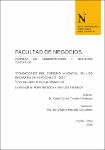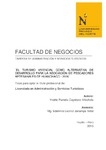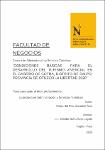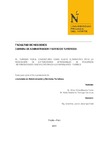Mostrar el registro sencillo del ítem
Condiciones del turismo vivencial en los balsares de Huanchaco – 2017
| dc.contributor.advisor | Hurtado Castañeda, Jamy María | |
| dc.contributor.author | Camino Cárdenas, Carla Cecilia | |
| dc.date.accessioned | 2018-11-08T18:47:40Z | |
| dc.date.available | 2018-11-08T18:47:40Z | |
| dc.date.issued | 2018-09-28 | |
| dc.identifier.citation | Camino, C. C. (2018). Condiciones del turismo vivencial en los balsares de Huanchaco – 2017 (Tesis de licenciatura). Repositorio de la Universidad Privada del Norte. Recuperado de http://hdl.handle.net/11537/14015 | es_PE |
| dc.identifier.other | 338.4791 CAMI 2018 | es_PE |
| dc.identifier.uri | https://hdl.handle.net/11537/14015 | |
| dc.description.abstract | La tesis denominada CONDICIONES DEL TURISMO VIVENCIAL EN LOS BALSARES DE HUANCHACO – 2017, se basó en la variable turismo vivencial referente a condiciones positivas y negativas que se presentan en la actualidad para el desarrollo de dicha actividad turística. Se procuró mostrar el nivel de interés que presentan los pescadores artesanales locales sobre la importancia de los Balsares de Huanchaco y, al mismo tiempo, los beneficios que el turismo vivencial trae consigo en relación a las actividades turísticas como es en este caso la pesca artesanal Huanchaquera. Este trabajo de investigación pretende también estudiar a los pescadores locales y las actitudes que muestras para formar parte de la actividad turística, puesto que son los principales actores e involucrados en este tema y quienes día a día acrecientan más la identidad por proteger y salvaguardar los balsares, además, se esfuerzan por mantener vigente una práctica milenaria (de generación en generación); una práctica que es parte de un atractivo turístico como lo es el Balneario de Huanchaco. Los datos obtenidos fueron extraídos de fuentes de información primaria, como fueron los 6 pescadores de Huanchaco, quienes en su mayoría mostraron poco interés debido a que desconocían del tema, y otros presentaron una actitud poco amable debido a que ya no confían en los estudiantes y sus investigaciones. Las fuentes de información secundaria utilizadas fueron proyectos de investigación y de desarrollo desde el ámbito local, regional y nacional del turismo vivencial en los Balsares, así como las diversas consultas que se realizó a libros. Los métodos que se utilizaron fueron el Analítico-Sintético el que permitió abordar las condiciones que presentan los Balsares de Huanchaco para la práctica del turismo vivencial y el Etnográfico que permitió relacionarse con los aspectos tangibles del campo de estudio, registrando detalladamente lo que se pueda observar. Las técnicas que se utilizaron fueron la observación directa que permitió reunir rasgos y características tangibles que presentan los Balsares de Huanchaco para el desarrollo del turismo vivencial en dicha zona y la técnica de encuesta que se aplicó a los pescadores quienes actualmente son los únicos que se preocupan por preservar y conservar los humedales. Entre los instrumentos que se utilizaron fueron: Fichas Técnicas Especializadas para el recojo de información de los Balsares de Huanchaco, las mismas que se presentaron con una Guía Metodológica de Observación para facilitar el trabajo de recojo de información. Libreta de Campo la cual permitió plasmar aquellos datos que fueron observados en las salidas de campo pudiendo determinar la situación favorable o desfavorable de los Balsares permitiendo reconocer las condiciones que presenta la encuesta, la cual sirvió para identificar datos personales, tipo de trabajo de los pescadores, nivel de satisfacción sobre dicha actividad y la importancia que tiene para ellos dicha fuente natural. Cámara Fotográfica Digital y Grabadora para captar imágenes y detalles en la zona de estudio, a fin de complementar la descripción de los Balsares, así como de todas las características propias, los cuales son necesarios e indispensables para la práctica de la actividad turística vivencial. El primer capítulo hace referencia a la realidad problemática actual en el área de los Balsares de Huanchaco y la poca actividad turística vivencia que se practica en la zona. Posteriormente, en el segundo capítulo, se encuentra el marco teórico que detalla los indicadores del turismo vivencial, definiciones según autores y las condiciones que presenta el realizar dicha actividad en los Balsares de Huanchaco. En el tercer capítulo se detalló la metodología empleada para la variable en mención ya que, siendo esta investigación de tipo no experimental, descriptiva-transversal, se ha aplicado una encuesta a seis pescadores activos de la Asociación de Pescadores Artesanales de Huanchaco. El cuarto capítulo permitió tabular y analizar los resultados que se obtuvieron a partir de la aplicación de la encuesta anteriormente mencionada Finalmente, en el quinto capítulo, se encuentra la discusión en función a los resultados obtenidos, luego de haber aplicado la encuesta. | es_PE |
| dc.description.abstract | The thesis called “CONDITIONS OF THE LIVING TOURISM IN LOS BALSARES DE HUANCHACO – 2017”, was based on the experiential tourism variable referring to positive and negative conditions that are currently present for the development of this tourist activity. The aim was to show the level of interest shown by the local artisanal fishermen on the importance of the Huanchaco balsares and, at the same time, the benefits that the experiential tourism brings with it in relation to the tourist activities as in this case the Huanchaquera artisanal fishing. This research work aims to study the profile of local fishermen and the attitudes they show to be part of the tourism activity, since they are the main actors and involved in this issue and who, day by day, increase their identity to protect and safeguard the In addition, Balsares strive to maintain a millenary practice (from generation to generation); a practice that is part of a tourist attraction such as the Balneario de Huanchaco. The data obtained were extracted from primary information sources, such as the fishermen of Huanchaco, who mostly showed little interest because they did not know about the subject, and others presented an unfriendly attitude because they no longer trust the students and your investigations. The sources of secondary information used were research and development projects from the local, regional and national level of experiential tourism in Balsares, as well as the various queries that were made to books. The methods that were used were the Analytical-Synthetic one that allowed to approach the conditions that present the huts of Huanchaco for the practice of the existential tourism and the Ethnographic one that allowed to relate with the tangible aspects of the field of study, registering in detail what can be observed. The techniques that were used were the direct observation that allowed to gather characteristics and tangible characteristics that the Huanchaco balsares present for the development of the existential tourism in that zone and the survey technique that was applied to the fishermen who are currently the only ones who worry for preserving and conserving wetlands. Among the instruments that were used were: Specialized Technical Sheets for the collection of information of the Huanchaco balsares, the same ones that were presented with a Methodological Observation Guide to facilitate the work of gathering information. Field notebook which allowed to capture those data that were observed in the field trips, being able to determine the favorable or unfavorable situation of the Balsares, allowing to recognize the conditions they present. Survey questionnaire which was used to identify personal data, type of work of the fishermen, level of satisfaction with said activity and the importance that this natural source has for them. Digital Photographic Camera and Recorder to capture images and details in the study area, in order to complement the description of the Balsares, as well as all the own characteristics, which are necessary and indispensable for the practice of the experiential tourism activity. The first chapter refers to the current problematic reality in the area of the Balsares de Huanchaco and the little tourism activity that is practiced in the area. Later, in the second chapter, we find the theoretical framework that details the indicators of experiential tourism, definitions according to authors and the conditions that this activity presents in the Balsares de Huanchaco. In the third chapter the methodology used for the variable in question was detailed since, being this research of non-experimental, descriptive-transversal type, a survey has been applied to six active fishermen of the Association of Artisanal Fishermen of Huanchaco. The fourth chapter allowed to tabulate and analyze the results that were obtained from the application of the aforementioned survey Finally, in the fifth chapter, the discussion is based on the results obtained, after having applied the survey. | es_PE |
| dc.description.uri | Tesis | es_PE |
| dc.format | application/pdf | es_PE |
| dc.language.iso | spa | es_PE |
| dc.publisher | Universidad Privada del Norte | es_PE |
| dc.rights | info:eu-repo/semantics/embargoedAccess | es_PE |
| dc.source | Universidad Privada del Norte | es_PE |
| dc.source | Repositorio Institucional - UPN | es_PE |
| dc.subject | Marketing - turismo | es_PE |
| dc.subject | Pesca | es_PE |
| dc.subject | Condiciones económicas | es_PE |
| dc.subject | Turismo | es_PE |
| dc.subject | Regulación industria del turismo | es_PE |
| dc.title | Condiciones del turismo vivencial en los balsares de Huanchaco – 2017 | es_PE |
| dc.type | info:eu-repo/semantics/bachelorThesis | es_PE |
| thesis.degree.grantor | Universidad Privada del Norte. Facultad de Negocios | es_PE |
| thesis.degree.level | Título Profesional | es_PE |
| thesis.degree.discipline | Administración y Servicios Turísticos | es_PE |
| thesis.degree.name | Licenciado en Administración y Servicios Turísticos | es_PE |
| dc.publisher.country | PE | es_PE |
| dc.subject.ocde | https://purl.org/pe-repo/ocde/ford#5.02.04 | es_PE |
| thesis.degree.program | Pregrado | es_PE |
| dc.description.sede | Trujillo El Molino | es_PE |
| renati.advisor.dni | 18214972 | |
| renati.advisor.orcid | https://orcid.org/0000-0002-3456-837X | |
| renati.author.dni | 46497202 | |
| renati.discipline | 014146 | es_PE |
| renati.level | https://purl.org/pe-repo/renati/level#tituloProfesional | es_PE |
| renati.type | https://purl.org/pe-repo/renati/type#tesis | es_PE |
Ficheros en el ítem
Este ítem aparece en la(s) siguiente(s) colección(ones)
-
Tesis [104]






